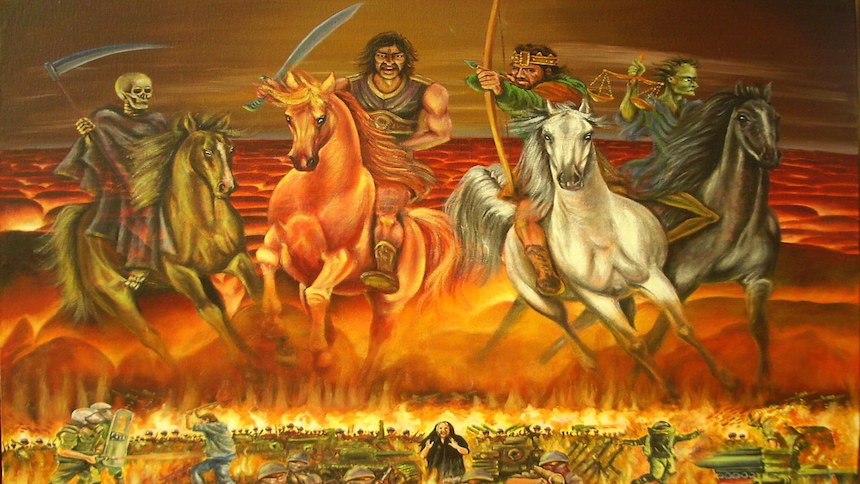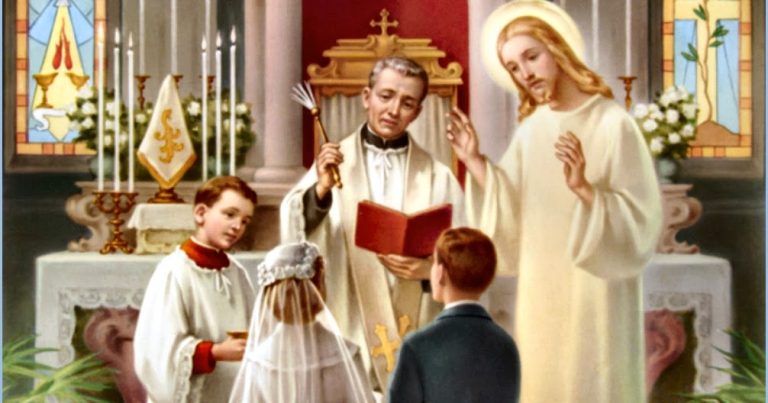Learn all about the Apocalypse, the most feared book in the Bible
The apocalypse is known as a book of revelations and has long been considered the only book with prophetic status. Learn more about the subject in the next post.
Apocalypse
Revelation might be the most extravagant content scripture in the entire Bible. The measure of images, symbolism and procedures tend to confuse the task of translating the whole message and, all things considered, has been the subject of various examinations, clarifications and debates since the beginning of time.
History
The writer of the Apocalypse recognizes himself within the book as John, and in a state of exile on the island of Patmos, right in a place known as the Aegean Sea for taking the position regarding Jesus.
The fortuitous occurrence of this name with that of John the Evangelist and the writer of other New Testament compositions is largely the motivation behind why the book is generally credited to the messenger Saint John and not to another author.
However, in that book, the writer only refers to his name, he never distinguishes himself with a similar messenger or as having any special charge, John of the Gospels, nor does he handle a similar writer of different works belonging to the missionary.
Most of the pastors of the early Church, or Apostolic Fathers, some of them are Saint Papias, Saint Polycarp or Saint Justin, the considered Saint Hippolytus, Saint Irenaeus, and others. All of them insisted that the writer of this awakened book was simply the evangelist, an advocate for the Lord.
In the year 633, the IV Council of Toledo that tried to clear up the uncertainty made only in the last area of the III century, when no follower who had dealt with or knew the writer of the fourth gospel lived, said that the Apocalypse was created by the Evangelist . and that it should be seen as a heavenly work and surely sanctioned, criticizing the ban to the people who denied it.
For the Catholic Church to regularly think of the book as the writer of the apostle John, the so-called Evangelist equivalent, which is a supernaturally quickened book and is a piece of Holy Scripture, you must have confidence in reading it. (See Article: The Bible )
In spite of everything, today’s current examinations group the works accredited to Juan and some that confirm that they have a place with a supposed network called “Johannine”. This position would not really show the immediate initiation of missionary John, however, a network established by him or strongly affected by him would produce these reports.
In this sense, he maintains that regardless of whether John had not composed the Apocalypse in calligraphy, it would be as if he had done so through this network.
Furthermore, they feel that naming a famous person as the creator of the works was customary in the writing convention of the whole world, not to give additional credit, but false, but since in truth the genuine writer relates completely to the character who stands out as the creator of the work.
Historical setting
Truly, he realizes that the Apocalypse or the revelations were composed right in the first centuries, when the Roman abuses against the Christians were even more lurid, at the time of the emperor Domitian, who was Caesar of the Roman Empire in the first century.
This, similar to some sovereigns, requested, either out of direct vanity or as a system of intimidation to their subjects, that their statues be worshiped throughout the domain, something that Christians would not achieve for religious reasons: the Caesars called themselves themselves ‘Master of lords’, despite ‘sons of God’, titles that Christians have only for Jesus Christ.
Therefore, the Apocalypse would also convey an authentic basis that would make numerous references to these abuses and to the guidance that the writer would provide to his readers, Christians, to remain in confidence to persevere through the anguish, putting any expectation of the new Jerusalem as a prize, of course for people who were firm.
The Apocalypse is seen as one of the most questionable and problematic books of the Bible, due to the variety of possible translations that integrates the results of the names, occasions and images that are described.
The affirmation of this content in the biblical standard of the New Testament was difficult, the debate among the Church Fathers regarding the canonicity of the Apocalypse continued for some centuries.
Recognition of the Apocalypse
Starting in the first century, the agents of the main houses of worship perceived the Apocalypse as a certified work of the witness John. In Asia, Melito, Bishop of Sardis, perceived the Apocalypse of John and composed a discourse on it, better known as “Eusebius of Caesarea”, Ecclesiastical History, IV.
For his part in Gaul, Irenaeus of Lyons had unshakable confidence in his incredible and skilled missionary. In Africa, Tertullian largely referred to the Apocalypse without obvious questions about its reality and without concluding. In Rome, Bishop Hippolytus apportioned his creation to John, and the Muratorian Fragment records it along with other authoritative writings. (See Article: Old Testament )
In addition to this, the Apocalypse emerges as a motivator, and they list it as a book with unique and debatable characteristics. Athanasius, diocesan of Alexandria, fully remembered him in his Easter letter. As well as Augustine of Hippo in his book On Christian Doctrine, Rufinus of Aquileia in his commentary on the apostles, Pope Innocent I in a letter to Bishop Toulouse and John of Damascus in his book An Exposition of the Orthodox Faith.
In the West, the book was certainly recognized by the announcement of Pope Damasus I, in 382, later affirmed by the Synod of Hippo in a congress at the time. The Council of Carthage, the Council of Florence and finally by the Council of Trent along with the various compositions of the New Testament.
In the East, it became standard after much discussion that continued into the 9th century despite the fact that it is the main book of the New Testament that is not examined as a feature of formality in the Orthodox Church.
Contradictions about the Apocalypse
Regarding the contradictions, Gaius Romano, towards the beginning of the third century, was the first to reject the Apocalypse for advancing and supporting the millennial current at all times.
The most important opponent of the expert on the Apocalypse was Dionysus, diocesan of Alexandria, a devotee of Origen. He did not contradict the possibility that Cerinthus was the writer of the Apocalypse, but rather he highlighted the idea of him. In his work on guarantees he expresses:
“This is the regulation instructed by Cerinthus: the kingdom of Christ will be natural. What is more, since he appreciated the body and was totally licentious, he imagined that he would discover those achievements he craved, in other words, eating, drinking, marrying: amid meetings, penances and immolations of holy persons for what he tried to do that theory was more and more valuable.
Another supporter of Origen, Eusebius of Caesarea, could not help contradicting his Alexandrian educator by dismissing the Apocalypse as a composition of Scripture, even though he had to perceive its almost universal recognition. The express:
“The Apocalypse is recognized by some of the accepted books, but others dismiss it.”
Cyril of Jerusalem did not name it among the standard books; neither does it appear in the summary of the Synod of Laodicea, nor in that of Gregory of Nazianzus. Another argument against the missionary authorship of the book is its exclusion from the Peshitta version, the Aramaic Syrian Vulgate.
In the fourth century, Saint John Chrysostom and different ministers fought against the incorporation of this book into the New Testament standard, particularly because of the challenges presented by its clarification and the dormant threat it might imply. The Christians in Syria, moreover, discarded it because the mountaineers relied heavily on it. (See Article: New Testament )
In the 9th century, it was incorporated together with the Apocalypse of Peter among the “examined” books of the Sticometry of Saint Nicephorus, Patriarch of Constantinople. Martin Luther thought that the Apocalypse is “unbiblical and unprophetic”, saying that “Christ is not educated or thinks of him here”.
Explanation
The reading of the book of Revelation should be possible in a few planes, as demanding, representative, for its artistic type, with the environment where it was composed, for the fundamental message it speaks of, and many other things.
It is important to see each of these levels to understand the book of Revelation and refrain from translating it only from the point of view of everyone’s own ideas that in the end attend exclusively to the fear that would cause a greater impression:
An accurate reading of the book can leave various impacts on the reader, however, it is important not only to stay at this level, but to go beyond it for a higher understanding. From now on, emphasis is placed on understanding a theme and the system that made such interpretive content conceivable.
That approach suggests that when a journalist discovers John’s revelation, they must discover the criteria and the strategy used.
The degree of classification that it possesses is significant, since it allows us to place the Apocalypse within the framework of different books, both scriptural and non-scriptural, that with a comparative structure or symbology can offer light to understand what the writer of the book really needed to express.
The Apocalypse of John has a place in the reality of all Apocalyptic-type writers, even though it has some qualities that set it apart from the rest of the books.
The chronological level also allows us to find the writer’s time, along with emergencies and occasions that might have affected the composition of the book in general, and certain specific sections.
On a representational level, it is also conceivable to understand what the various images that appear in the book would speak to the writer. It is important not to overlook that, in the end, the book is a Christian composition, and that, all things considered, it infers the message found in the Gospels, centered on the figure of Jesus Christ.
In the same way, an exam can be incorporated that incorporates the structure from the perspective of the language where the book was composed, that is, in Greek.
Interpretive Schools
As the expert Hahn indicated, there are fundamentally four interpretive schools that make mention of the Apocalypse, to be specific, these are:
Innovative : Includes the distinctive proof of the characters of the Apocalypse with several of them that have been developed throughout the history of humanity, for example, the identification of the Beasts of the Apocalypse with Napoleon Bonaparte, Adolf Hitler, Mao Tse-Tung or Joseph Stalin, and others of less importance.
Historicist: The Apocalypse maintains that it uncovered God’s final strategy for history, from beginning to end, including the specific history of the Church.
For Hahn, each of these schools has its raison d’être and its honesty, and although this creator supports the cautious view above all, he does not totally rule out any of the different schools.
Vanni expresses that from this point of view the message of the entire book of Revelation can be updated at the time of any Christian time, or rather any network of Christian followers. For their part, the statements in the book are constantly aimed at a gathering of individuals, not just someone out of touch.
Therefore, from the preterist or religious point of view, the Babylon that could have spoken with the writer about the lost Rome, a predominant, consumerist and agnostic city, could speak today in infinite comparable specific circumstances.
However, taking into account to properly perceive what those circumstances are and not to take the interpretation to the extraordinary (in other words, in a kind of modern point of view but without scratching the distinctive proof, avoiding believing that the Apocalypse had been expressly composed to “anticipate” the realities of some time).
That is the reason for the Apocalypse, the book of the seven seals does not decipher it, nor could it be translated or even opened, by anyone, only the Lamb, as he tells the network, that the Lamb should be his paradigm consistently.
In addition, numerous schools can be perceived with different types of translation of the Apocalypse, for example, the hidden vision and that of the Churches, for example, the Catholic, the Eastern Orthodox, the Anglican or the Mormon, some of which incorporate components of different schools, of which those referred to and those of different Churches are pointed out, however, they are very characterized in their principle.
The seven quotas again in a numerical image, calamities are discussed and the last fight that begins with the gathering of the armed forces in a place called Armageddon.
For its part, the prostitute, the one known as Great Babylon, enters the scene, which is confirmed by the Beasts and the Dragon. At that moment, Christ rides on a great white horse, the great harlot is vanquished, and the beasts are caught and thrown into the pool of flames.
The Beating: Reference is made to the Dragon being trapped for a thousand years after triumphing in times past and that he will finally return to gather all the countries to be vanquished once more, this time conclusively.
The New Jerusalem: The vision ends with the creation of the earth and the new sky, these are made once again, the New Jerusalem, as an image of the city of God, is the whole earth where now Jesus when he comes will live directly in middle of all men.
Septenary Structure of the Apocalypse
The structure of the Apocalypse can also be seen or classified in septenaries: It is isolated in 7 meetings, each of them can be subdivided into subgroups of 7 together with preludes, intermediates and different trips.
Numbers and nuances
Among the various images present throughout the book, two fundamental aspects stand out: the “numbers” and the “nuances”. Many of the expressions in these images are, “truth be told”, “idealized truth”
Numbers
It refers to the fact that the various numbers in the Apocalypse constantly have an emblematic character. The importance of these would lie in the meaning of each one. Meet them below:
One: Normally used to refer to the only God.
Half, three and a half: Apparently these are numbers that are taken directly from the book of Daniel; they speak to a limited time, which would not end in one, which means the totality of God or four, which means the natural or all-inclusive, despite being half of seven. The three and a half is further reflected in the expression of a period, times, and a large part of a period.
This division into three sections could also be founded on a clarification of Daniel’s specific seventy-week prediction, with a comparable division into three sections: referring to 49 years + 434 years + 7 years, from one of the announcements given by the Persian lords for the Jews to withdraw from there.
The Babylonian imprisonment, of which the best known were those of Cyrus the Great in 538 BC. CC Also, that of Artaxerxes I Longímano in 457 a. C. In the same way, the thousand two hundred and sixty days mentioned in the book, like the forty-two months, are proportional to three and a half years, all this justifies the use of both terms.
Four: May refer to the natural or universal, or creation, for the four cardinal focuses, and applies similarly to the living four who meet God towards the beginning of the vision, and which some relate to the four evangelists (although the last one has little vocation).
Be that as it may, in light of the images of all creation, the four living creatures who are with God could speak to God’s territory about all creation and their association with their creator.
Six: In certain environments it means defect, since one is missing to reach the ideal figure. On the other hand, in addition, each of the four living who are next to the honored position of God have at least six wings.
Seven: For the Jews, the number seven (in Hebrew, sheba) indicates sinlessness.
This number is available in numerous Old Testament and New Testament books, consistently of similar importance.
Twelve: It speaks above all of the twelve clans of Israel, and by expansion to the individuals of God. In Christian fashion at the time, this number speaks to Christians who, as its translation indicates, are God’s new individuals, specifically those targeted by the number of missionaries.
Thousand: This number would not speak to the exact measure of 1000, however, the general thought of a large number for example, the thousand years of the Dragon’s restraint before it rises again and is perpetually defeated, would not speak for a moment precision thousand years but only the general thought of a long time.
Essentially, a few different numbers appear in the book, which after the clarification of the destructive writing of the whole world, also have an emblematic meaning.
All three, for example, can speak with God, and despite the fact that for the Jews themselves the number three is henceforth illustrative of the heavenly nature, from the Christian perspective it does so additionally by considering the Father, Son and Holy Spirit of the Trinity.
On the other hand, in Revelation, the three appear as a portion, rather than as the complete number (33%, 33%, further showing that it is neither the complete one of God nor the complete four of creation, and that 66% are not influenced by what is the third party). The different numbers also appear as two, ten, among others.
the septenaries
The book of Revelation contains the arrangement of the number 7 throughout its body. The most infamous are found in the connection between the three septenaries of seals, trumpets, and bowls. The septenary occurs when the Lamb individually opens the seals of a book that no one could open except him.
Before breaking the seals, the vision is in paradise, with the theophanies of God, the Lamb, and the delight that makes him have the option of opening the book. The initial four seals begin with the Horsemen of the Apocalypse. Seals 5 and 6 cause disorders.
After the sixth seal there is a dream of expectation (the 144,000) and with the seventh seal the septenary that accompanies it begins: the trumpets, and with them, truth be told, the rest of the book that ends with the last vision of the New Jerusalem.
The trumpet septenary begins with a heavenly vision of expectation, fundamentally the 144,000 equivalents that precede the seventh seal that harmonizes with the main trumpet, at which point the trumpets are sounded, united by disasters. After the sixth trumpet, a dream of expectation arrives (the sacred messenger and the little book, the two observers). At the moment the seventh trumpet is blown, there is a triumphant melody.
The septenary of cups appears somewhat later. Once again, it begins with a heavenly vision of expectation. At that point, the cups spill over, joined by riots. After the sixth cup, although submerged in a beating atmosphere, comes a guarantee of expectation.
The end of this septenary, after the seventh bowl is poured out, begins with the introduction of the whore of Babylon, but sees that it quickly begins to wane.
In this sense, the three most important septenaries of the Apocalypse have a similar structure: a divine vision that is the prelude to trust, a progression of natural disturbances, after the sixth image of the apocalypse there is an interval of expectation with respect to the rest of them.
Different septenaries of the book, some to a certain extent hidden, are found in the places of worship to which the writer addresses himself, which are the equivalent of the letters to the Ephesus and Fidelia Churches; in the referenced blessings; in formal approvals to Christ; in the spirits that are before the royal position of Jesus Christ, and so on.
In this unique circumstance, the structure of the Apocalypse can also be broken as indicated by the septenaries.
Characters and figures in the symbology
Uniting the importance of the diverse symbology of the Apocalypse, a variety of characters and figures can be found from time to time examined and considered within. Despite the book, the Ark of the Covenant and the segments of the septenaries (the 7 seals, the 7 trumpets and the 7 bowls), arranged by appearance, a part of the figures of the Apocalypse are:
The Four Horsemen of the Apocalypse, by Albrecht Dürer
The image of the steeds originates from the book of Zechariah, where it is constructed that they are sent by God. Mounting each one on a horseman with a characteristic shadow, these horsemen spread infections to all of humanity (remembering that the number 4 speaks to all creation, so diseases would spread throughout the earth). Remembering the importance of tones, the most widely recognized understanding of what each pilot is talking about would be the accompaniment:
- Red rider, refers and speaks to war.
- Dark rider, speaks of hunger, need.
- Green or yellow rider, speaks of death or illness.
The White Rider, speaks for some of the demise, for the way he usually wins, but for other people, for the shading, for the way he wears a crown, and for the way Christians don’t accept that the step is invulnerable, he would prefer to speak with Christ (or a horseman in his representation), also alluding to Revelation 19, where the White Horseman returns, with Christ riding him.
The 144,000
It should be noted first that 144,000 is equal to 12 x 12 x 1000, that is, remembering the importance of numbers, it is a number that speaks of a large quantity, that is, 1000, increased by the square of the whole, that is, significantly greater, in relation to the individuals of God.
This figure can actually be translated from the book of Revelation as the number of individuals that would be spared towards the end, but reading later, you may read the following: … I also observed a group that no one could count, from every country, race, and language …which can also be translated as how the number 144,000 would not be precise or strict, but simply delegated by God in scripture.
The total of 144,000 is given for the totality of twelve thousand individuals from each clan of Israel. As there is an anomaly in this summary of clans, it does not appear in any other summary of the clans of Israel in the entire Bible. (See Article: Prayer of thanks to God for a new day )
In any case, the clan of Judah appears, since it would be smart for people who are clear about where the Messiah originates from according to the predictions of the Old Testament. At that moment Reuben’s clan arrives, who, being Judah’s older brother, did not win.
On the other hand, the clans of Dan do not appear, nor does that of Ephraim, which appears in different publications, but those of Levi and Joseph. And then the strangest part, in case you remember that the clans of Israel are related to the 12 sons of Jacob, and that he had his twelve sons by some spouses: two slaves, Zilpah and Bilhah, and two royal youths as Leah and Rachel.
When all is said done, one would expect, as is currently the case in various publications, that the descendants of non-slave spouses are recorded first, and those of slaves last. In the summary of Revelation, following the reference to Judah and Reuben, the clans of the descendants of the slaves (Gad, Asher and Naphtali) are recorded first and, in conclusion, the rest of them.
The beast and his number
This is one of the most popular images acquired from the book of Revelation. The number 666 is usually related to the Devil, although here the Dragon of the Apocalypse illustrates it or the Antichrist.
However, in the Apocalypse, this figure is only mentioned once, to indicate that it is the amount of the Beast that serves the Dragon and then it is related to the sign of the Beast that would be used by each of the people who attend. with the dragon and the monster.
It must be remembered first that the importance of the number 6 is a mark, due to the absence of a unit for the impeccability of the number 7, and the number 666 would then speak of a defect transmitted to those who believe in it.
There are writers who try to distinguish the number 666 with a verifiable character from the time in which the book was composed, since in several biblical writings it proposes that the Antichrist was a character of the hour of witnesses.
Furthermore, every soul that does not admit Jesus is not of God; and this is the soul of the antichrist, which you have heard that he comes from, and which is currently on the planet.
In addition, based on this, they try to locate a numerical game (known as gematria) with the letters of the Greek set, the language in which the book was composed that could give equality to perceive the main Beast of the Apocalypse with this number.
These games were basic for the time of the composition of the Apocalypse, and the remains of them have also been found in different works. Each letter (alpha, beta, gamma, psi, omega) is allocated a number: the first from 1 to 10 (with the exception of 6), at that point ten from ten to 80, at that point 100 and one hundred out of one hundred to 800.
A word or expression known at the time had a number related to it by adding the comparable numbers to each letter; The reverse of this game is to give a number (similar to the instance of 666 in the Apocalypse) and try to recognize which word or expression also meets these attributes.
After this numerical game, it could be reasoned that the number would speak to Domitian, who wronged the Christians at the time of the sacred text of the Apocalypse, or all the Roman Caesars who transmitted divine beings to themselves and requested that their subjects, consequently their statues were adored.
Likewise, some examinations reason that the number 666 given in this Revelation entry is not correct, as there are some forms of the book dating from the second or third century that have the number of the Beast as 600 and sixteen (and with which through a similar number of games they could be identified with some Roman Caesars, for example Caligula, a Roman ruler portrayed for his mercy).
Similarly, with different images of the Apocalypse, there are numerous understandings that distinguish the Beast with characters of various types from the beginning (and that through different games perceive the prophetically catastrophic 666 with them). There are even clarifications distinguishing 666 with dates.
The main beast and the two witnesses
Others handle the plausibility of distinguishing the Beast that the writer of the Apocalypse would really overlook, with the emperor Nero, who by composing the book today would leave a memory of the torments and oppressions of his time.
Taking the expression Nero Caesar, in Hebrew or Greek, considering only the consonants and taking the numbers according to a numbering of the Hebrew letters in order, like the previous one, the total would once again give the well-known number 666. Furthermore, if you take the expression ‘Nero Caesar’, however, not in Greek but in Latin, the subsequent number is 616.
Within the book of Revelation, reference is made to the fact that a first Beast kills two Witnesses of God in a city, who, by the way, after the dead are revived after three and a half days and are raised to paradise in perspective over their enemies .
The representation of two observers is according to the Jewish law that expresses that alone the declaration of two observers is recognized. Some have needed to perceive in these two witnesses the missionaries Peter and Paul, killed during the time of Nero. In any case, in Revelation it is not perceived that this first Beast is equivalent to that of the number 666.
For Hahn, the two observers speak with the prophet Elijah and Moses, characters who would thus personify all the law and the prophets of the Old Testament.
Another translation given to the two Witnesses is that they are compared to Elijah and Enoch, with the argument that in all the history that the Bible says that these two characters have not passed: Elijah was taken to paradise in a hurricane before a chariot of flames who isolated himself from Elisha and Enoch:
Enoch walked with God and disappeared in light of the fact that God brought him. Since every man must die, and these two characters have not passed, the related occasion in Revelation is supposed to be the time of his demise.
Babylon and the whore
Prostitute of Babylon, this image could be the political suggestion that at the time of composing the book, the writer would make his opponents: As a matter of first importance, remind him that for the Jews, the city of Babylon speaks of banishing, after that the Babylonians overthrew the top of Jewish society in Jerusalem in 587 B.C. c.
In the same way, he proposes the corruption of Jewish traditions, which were mixed with components of admiration in that city, a transgression censored by them. Therefore, Babylon speaks to both external commanding force and adoring admiration.
That is the reason in the Apocalypse, as in different books of the New Testament, Babylon is regularly distinguished with the magnificent Rome that wronged the Christians and requested that they love Caesar as a divine being.
To tell the truth, in the Apocalypse, in the representation of Babylon with its seven mountains, the city of Rome could be perceived. The whore of the Apocalypse would then have a similar importance of corruption, admiration and Strike for the Roman high culture of the time.
On the other hand, others recognize Babylon with the Jerusalem of the Jews (which also has seven mountains), and that it stands out strongly from the New Jerusalem towards the part of the deal. For example, Hahn, 2001, who largely concentrates his understanding of the calamities of the Apocalypse in relation to the fall of Jerusalem in the year 70.
The woman clothed with the sun and the child
The “lady clothed with the sun, the moon under her feet, and on her head a crown of twelve stars” appears in Revelation as the one who conceives the child the Dragon needs to fight. This guy is ‘stolen’ from paradise and then rules, so the Dragon fights the woman and then the rest of his posterity.
The way of perceiving women is different. From a point of view that considers the Apocalypse as totally Christocentric, it can be deciphered very well that the child would speak adequately with Christ.
From the point of view of Mariology, this lady would see an image of the Virgin Mary. However, there are numerous Christian gatherings (from different churches, including some Catholics), who decipher in this image the individuals of God, that before Jesus was brought into the world they would speak with reliable Israel, and after that there would be Christians.
the new jerusalem
It is considered the best part of the entire Apocalypse, it is for some among the best portrayed, point by point and enchanting of the New Testament. With a triple repetition, the creator speaks about God’s salvation regarding humanity.
First with the proper new Jerusalem, which slips from paradise to Earth. At that time with the wedding of the Lamb and his wife (the Church). Finally, with a dream reminiscent of the main sections of Genesis (the main book of the Bible), waterways and trees that have ceaseless natural products are discussed.
This part is the one that in particular would have eschatological attributes, while the rest would be just an impression of the claims that the creator’s group of Christian people would live in their time and of the expectation established in God through Christ died and risen in which those disputes would not win and would be beaten at some point or another. (See Article: Miraculous Prayer of the Holy Spirit )
There is another interest both in the new Jerusalem, which symbolizes the blessed city, and in Babylon, which symbolizes the unreasonable city: in Revelation 18 it seems to cry for the devastated Babylon; The representation of the new Jerusalem appears in Revelation 21.
It can be very well noted that the two sections are parallel and opposite, that is to say, that the representations of clamor and negative meaning given to Babylon seem changed, in the feeling of joy and euphoria for Jerusalem.

Hello! Let me enthusiastically introduce myself as a dedicated blogger fueled by an intense passion for meticulously crafting insightful and well-researched blogs. My mission revolves around providing you, dear readers, with a veritable treasure trove of invaluable information.







